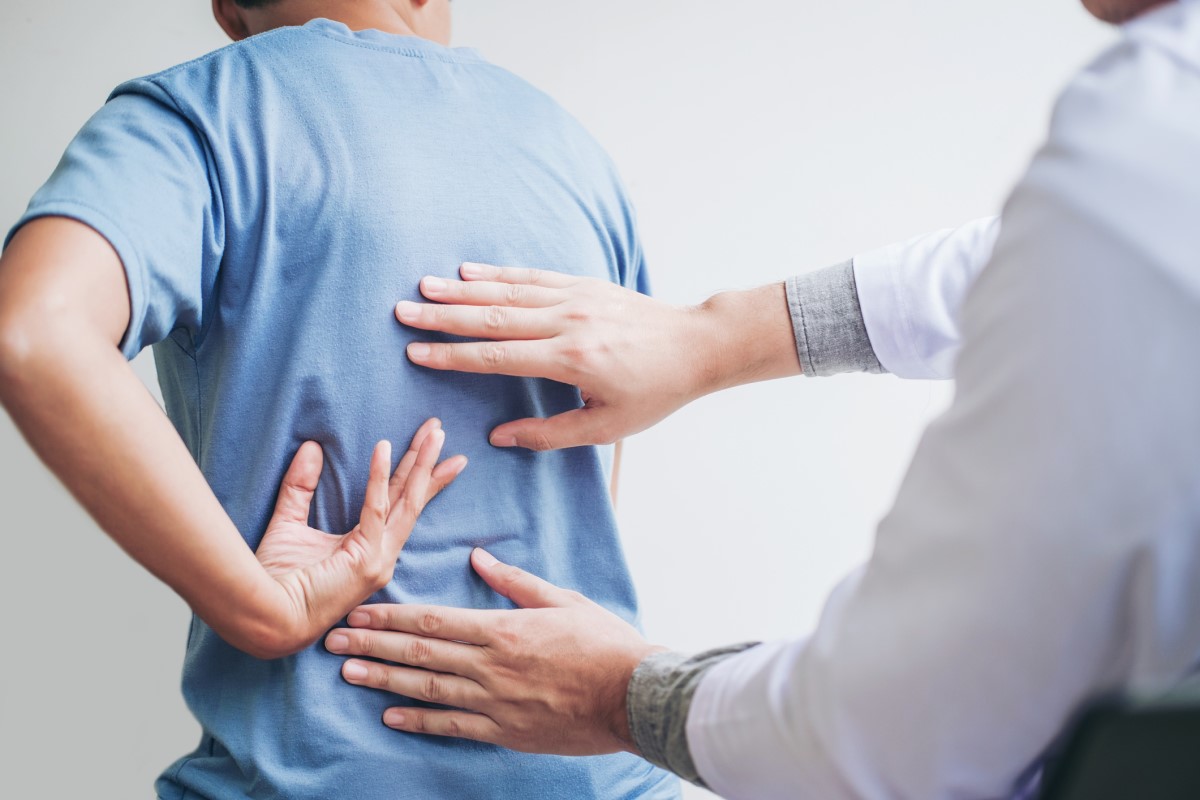- dorn-method.com - International Information Platform aboutthe DORN Method
- dornmethod.co.uk - The Dorn Method - A Different Approach to Back Pain Therapy
- handsonclinic.co.uk - Back Pain, Sciatica and Neck Pain treated with Dorn Method
How to straighten the spine? The Dorn method will help you

Straighten your spine! The Dorn method will help you.
Article content
Today, no one is surprised when an acquaintance in his thirties complains that he has been suffering from back, muscle, knee or walking problems for a long time. Today's hectic times, hours spent behind the wheel, on the computer or on the mobile phone make us experience these problems even two decades earlier than we should.
That's why a revolutionary method that promises to put an end to sore lower limbs without drugs and knives is becoming increasingly popular. How?
You'll be surprised, but it all starts with balancing the length of your legs. Because legs are not the same length. The miracle is called the Dorn Method.
What does unequal leg length mean?
Approximately 70% of the population suffers from this asymmetry in leg length. Of these, 0.1% have a difference in the length of the right and left lower leg of more than 2 cm.
There are two main types of leg length inequality:
1. The first type involves legs that are measurably different in length. This is usually due to a difference in the length of the bones themselves, either the femurs or the tibiae and fibulae of the lower limb.
It may be a genetic defect present from birth. Asymmetry can also arise as a result of trauma, fracture, hip surgery, severe infection or local damage to one of the growth plates.
2. The second, more common type occurs when the legs themselves are the same length. Asymmetry is present as a result of disruption of neuromuscular relationships in the pelvis or upper leg.
One lower leg or hip is held higher and tighter than the other (increased tension in the pelvic or leg muscles). These unevenly tensed muscles cause the legs to appear to be different lengths. Careful measurement will show that the legs are the same length.
This phenomenon is referred to as leg length asymmetry. It is most noticeable when lying down.
Who was Mr. Dorn?
It all started in the 1970s. A German man named Dieter Dorn was troubled by the deteriorating health of his wife, who suffered from constant pain in her cervical spine and head.
Repeated examinations by the best doctors in the country did not help. The therapies commonly available at the time did not bring Mrs Dorn any relief. It was not until one day that her husband noticed that one of the vertebrae in his wife's neck was out of its normal position. He applied gentle pressure to it. His wife moved her neck from side to side.
The crooked vertebra jumped into the correct position and from that moment on his wife was without any sign of pain.
Several decades have passed since that moment. In that time, the Dorn Method has become popular with many therapists, doctors and other health and care professionals.
The Dorn Method is a holistic therapy based on natural principles of physics, physiology and anatomy. It combines the findings of traditional Chinese medicine with Western healing techniques.
It uses the principles of manual therapy in self-help exercises. According to available sources and reviews, it has been producing excellent results for many years.
It has helped people who have suffered from severe back pain, sciatica, scoliosis, neck and hip pain, migraine, fibromyalgia, as well as various organic (internal) problems and non-physical ailments.
No medication or medical training is needed to successfully practice this method. It is easy to learn and master. All you need are healthy hands.
It is because of this simplicity that it has appealed to thousands of people all over the world. Even a gifted layman can quickly help himself and his surroundings or loved ones in many cases.
There are also professional centers where this method is practiced. There, of course, work doctors who have undergone several trainings in anatomy, physiology and physiotherapy and have great experience.
The basic principles of treatment
The method is based on the knowledge that our skeleton should be symmetrical, harmonious and in static-dynamic balance.
If we disturb this "bone order", our joints can become overloaded. This causes wear and tear and poor function in their interconnection, especially in the spine.
When this structural system is brought back into balance, people quickly begin to feel better. Symptoms such as pain and other problems may lessen or even disappear completely.
This method is based on correcting unequal leg length, which can be diagnosed in almost every person today.
In other cases, on the other hand, it is precisely this misalignment of the pelvis that causes the difference in limb length. This functional difference often leads to an asymmetrical, curved or rotated spine, as well as problems with the vertebrae and intervertebral discs.
Conventional Western medicine addresses these asymmetries by prescribing either special shoes or supportive shoe inserts.
In the vast majority of cases, however, the longitudinal limb discrepancy is diagnosed too late. Often it is diagnosed only at the stage when the curvature of the spine leads to the 'bulging' of the disc and the oppression of the nerve structures around it. This process causes persistent pain and problems with the function of the nerve itself, which is oppressed by the disc in the narrow spinal canal.
It is this problem that brings the patient under the neurosurgeon's knife.
The Dorn method proves that we can compensate for leg length differences every day, in several ways and procedures.
Is this a chiropractic method?
Static correction, which is the principle of chiropractic, is much more strenuous and unnatural to the body than the Dorn Method. The chiropractor must overcome the strength of stiff muscles and their natural protective tension.
Adding to the discomfort of the chiropractic procedure is the psychological strain on the patient. The patient may feel that the treatment is being done "on him" rather than "with him" and that he has no control over the situation.
In the Dorn method, the correction of hip or spinal deviations is accomplished by what is called dynamic or movement activity.
Our muscles create tension and pressure in the body to maintain the correct position of the hips and spine. If the muscles are not in natural harmony with each other, they take the incorrect position. They try to maintain this fixed incorrect position as the correct one.
This leads to the improper function of certain muscle groups and their overloading.
Muscles resist such stretching by stiffening.
A vicious circle is created. The stretched muscles are further overstretched, stiffen, shorten and deepen the curvature of the spine.
In a relaxed body, it is much easier to realign its stiff structures. Therefore, the basis of the Dorn method is to relax the muscles first and then manipulate the joints that hold the muscles.
It is a combination of pressure from the therapist and countermovement from the patient. The therapist leads the therapy, but the patient has the necessary control over his body.
The whole functional unit made up of bones, ligaments and muscles is involved in this action. This results in a total correction of movement.
The treatment combines the following 3 main factors
1. instruction on what stereotypes to avoid
Explaining the possible causes and contributing factors to spinal and hip problems. Serving to effectively and consciously avoid future difficulties.
2. Demonstration and practice of manual exercises
The therapist will demonstrate effective and safe exercises in cooperation with the patient. He will show that even with his own help, using the principle of a combination of counter pressure and movement, a person can return his joints and muscles to balance and correct position.
3.
After a certain period of time, the patient is able to perform all the exercises on his own. He is thus able to take care of his body on a daily basis. A few minutes spent every day, for example, performing simple exercises for the correct leg length can help keep the hips in place and the spine straight.
Before you achieve full recovery, you will need to spend quite a long time getting used to avoiding movements and habits that contribute to body asymmetry and incorrect movement patterns, along with self-care exercises.
One treatment usually lasts at least 2 months. After that, you should be able to do all the exercises independently. Of course, you need to exercise regularly as needed, even for life.
As with any lifestyle and exercise, discipline and regularity are most important.

What all problems can it solve?
The Dorn Method is primarily designed to address asymmetries of the spine and hips. Improving these problems leads to reactivation of the body's natural regenerative capacity in other organ systems as well.
Studies show that this method can help with many other problems besides those directly related to the skeleton and skeletal muscles.
These include:
- Fibromyalgia
- Allergies
- Diabetes
- Menstrual pain
- Digestive disorders
- High blood pressure
- Scoliosis
- Inflammation of the sciatic nerve
- Back pain
- Muscle tension
- Uneven leg length
- Headaches and migraines
- Knee pain
The Dorn Method and childhood
In childhood, during the infant and toddler period, the most common problems are traumatic injuries due to difficult and complicated birth, congenital abnormalities with onset before birth, or difficulties following shortly after birth, such as severe infections.
Especially after a complicated birth, subluxations of the cervical spine, pelvis and hips often occur. These problems need to be corrected as soon as possible.
Children often do not have a feel for their bodies. Different leg lengths and other musculoskeletal asymmetries do not necessarily manifest themselves only in pain. Children are more flexible and relaxed than adults due to incomplete growth, so they can tolerate longer asymmetries.
However, deviations from the norm are often reflected in their behaviour.
Examples include:
- frequent crying
- nervousness
- sleep problems
- frequent skin diseases and inflammations
- breathing problems
- hyperactivity
- recurrent colds
These symptoms can be the result of an incorrect curvature of the spine.
In later childhood, childhood migraine may occur. It is often associated with an incorrect position of the first vertebra of the cervical spine - the atlas.
Other symptoms that indicate a problem in the development of the child's spine are:
- children do not like to walk
- prefer to sit
- are often carried
- get tired easily
Fortunately, in very young children (up to school age) we do not have to correct the whole spine.
At this age, they are still very mobile and adaptable, so it is enough to prevent incorrect movement patterns. However, with asymmetry of the hips, cervical and sacral spine, proper attention should be paid to exercises that will alleviate impending future difficulties.
When exercising with children, similar principles apply as with adults.
Interesting article:
A childis not a miniature of an adult! What are the differences?
However, the approach should be much gentler, with more patience, taking into account the child's age, psychosomatic development or any accompanying illnesses. Parental training should take place in specialised children's movement centres or with a trained physiotherapist.
Interesting resources










